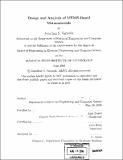| dc.contributor.advisor | Amy Duwel and Jin-Au Kong. | en_US |
| dc.contributor.author | Varsanik, Jonathan S | en_US |
| dc.contributor.other | Massachusetts Institute of Technology. Dept. of Electrical Engineering and Computer Science. | en_US |
| dc.date.accessioned | 2007-04-03T17:12:29Z | |
| dc.date.available | 2007-04-03T17:12:29Z | |
| dc.date.copyright | 2006 | en_US |
| dc.date.issued | 2006 | en_US |
| dc.identifier.uri | http://hdl.handle.net/1721.1/37109 | |
| dc.description | Thesis (M. Eng.)--Massachusetts Institute of Technology, Dept. of Electrical Engineering and Computer Science, 2006. | en_US |
| dc.description | Includes bibliographical references (p. 103-107). | en_US |
| dc.description.abstract | Metamaterials, materials that are constructed with arrays of small elements have significant potential to provide material properties that are useful for electromagnetic applications but are not found in nature. Slight changes to a repeated unit cell can be used to tune the effective bulk material properties of a metamaterial, replacing the need to discover suitable materials for an application with the ability to design a structure for the desired effect. However, most current metamaterial realizations are plagued by high loss, large size, awkward structure, or difficult construction. The use of Micro-Electro-Mechanical Systems (MEMS) to create a new metamaterial could improve upon some of these shortcomings due to their small size, high Q. and ease of integration into standard applications and circuit fabrication techniques. In this thesis. I analyze the prospects of a MEMS-based metamaterial. First, I determine the best type of MEMS resonator to use in a metamaterial. Then, I build models that can accurately describe a metamaterial constructed of MEMS unit cells. Analysis of these models provides information about the potential behavior of a MEMS metamaterial. It is discovered that it is possible to create a left-handed metamaterial using MEMS resonators. Finally, phase-shifting and antenna miniaturization applications are suggested as potential areas that can leverage the benefits of this new MEMS metamaterial. | en_US |
| dc.description.statementofresponsibility | by Jonathan S. Varsanik. | en_US |
| dc.format.extent | 107 p. | en_US |
| dc.language.iso | eng | en_US |
| dc.publisher | Massachusetts Institute of Technology | en_US |
| dc.rights | M.I.T. theses are protected by copyright. They may be viewed from this source for any purpose, but reproduction or distribution in any format is prohibited without written permission. See provided URL for inquiries about permission. | en_US |
| dc.rights.uri | http://dspace.mit.edu/handle/1721.1/7582 | |
| dc.subject | Electrical Engineering and Computer Science. | en_US |
| dc.title | Design and analysis of MEMS-based metamaterials | en_US |
| dc.title.alternative | MEMS-based metamaterials | en_US |
| dc.type | Thesis | en_US |
| dc.description.degree | M.Eng. | en_US |
| dc.contributor.department | Massachusetts Institute of Technology. Department of Electrical Engineering and Computer Science | |
| dc.identifier.oclc | 85480463 | en_US |
